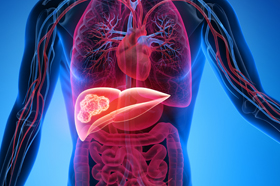Transarterial Embolization Influences Immune Response for HCC Based on Underlying Disease
 With transarterial embolization (TAE) being the most common treatment for hepatocellular carcinoma (HCC), researchers from the University of Pennsylvania and Corporal Michael J. Crescenz Veterans Affairs Medical Center (Philadelphia) examined the TAE-induced modulation of the tumor immune microenvironment in a rat model to identify factors that modulate this response. Their results, "Transarterial Embolization Modulates the Immune Response within Target and Nontarget Hepatocellular Carcinomas in a Rat Model," as reported in Radiology, indicate that factors such as underlying liver disease, embolic agent type and vascular location influence the TAE–induced dynamic alterations of the tumor immune microenvironment and can result in increased programmed cell death protein ligand-1 expression.
With transarterial embolization (TAE) being the most common treatment for hepatocellular carcinoma (HCC), researchers from the University of Pennsylvania and Corporal Michael J. Crescenz Veterans Affairs Medical Center (Philadelphia) examined the TAE-induced modulation of the tumor immune microenvironment in a rat model to identify factors that modulate this response. Their results, "Transarterial Embolization Modulates the Immune Response within Target and Nontarget Hepatocellular Carcinomas in a Rat Model," as reported in Radiology, indicate that factors such as underlying liver disease, embolic agent type and vascular location influence the TAE–induced dynamic alterations of the tumor immune microenvironment and can result in increased programmed cell death protein ligand-1 expression.
The study examined tumors from rats that underwent embolized tumors (target) and nonembolized tumors from rats that had a different target tumor embolized (nontarget) against a control group that did not undergo embolization. The researchers found that TAE influences the number and ratio of effector T cells within the tumor micro-environment of target and nontarget tumors and that the programmed cell death protein ligand-1 expression was higher in both target and nontarget tumors.
By delineating the dynamic transarterial embolization–induced cellular immune response in hepaocellular carcinoma, the data demonstrate the potential of locoregional embolotherapy to modulate the tumor immune microenvironment directly. The data may also provide insights into the nature, breadth, and mechanism of the induced alterations.
“These findings hold important implications for the ongoing development of therapeutic strategies combining locoregional therapy with immunomodulators as well as for the development of techniques and materials that further leverage the transarterial chemoembolization–induced modulation of the tumor immune microenvironment,” the authors conclude.